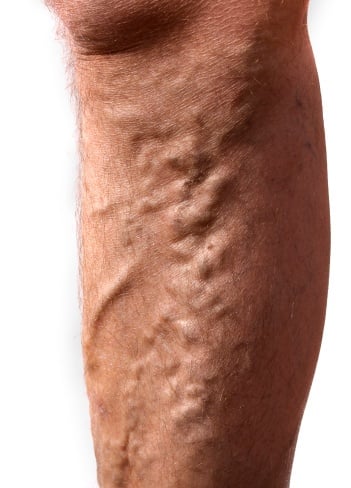In Part 1, we discussed ‘UGLY VEINS’ and the fact that they indicated Venous Disease with its associated venous hypertension. We learned that there are many risk factors associated with this problem, including inheritance, age, female gender, and long hours upright.
The associated symptoms and conditions included leg pain, fatigue, swelling, and visible veins of all types. Other symptoms can include things that were once thought not to be related to venous disease, such as Restless Leg Syndrome and Night Cramps.
Prevention and Treatment for Vein Problems
Prevention of problems from veins begins with the realization that you might be at risk. For example, if you are a tall female who has to spend long hours on her feet, you are at risk to develop venous disease, especially if you have a family history of varicose veins.
Because some papers have shown an association between venous disease and nicotine use, high blood pressure, and obesity, it makes sense to address these problems and move toward a healthier lifestyle. And, if you find yourself on a long plane or automobile trip, there is nothing wrong with walking a little bit every hour or so to keep the blood moving. Even doing exercises with your legs during prolonged sitting or standing will help circulate the blood, reducing the stagnation and helping to prevent blood clots.
If you have the time to elevate your legs with your heels higher than your hips, it is a good idea to do so for about 10-15 minutes whenever possible. These life style changes are good for everyone and can serve as prophylaxis for development or progression of underlying venous disease.
Compression therapy is the foundation of treatment for this condition. Compression therapy is the wearing of properly fitted, medical grade, support hose. Ideally, a vein specialist should be sought out for advice on the appropriate level of compression and proper fit. Compression can relieve symptoms and delay the progression of venous disease. Unfortunately, treatment utilizing compression will not cure the problem. More aggressive therapy is needed.
From the Phlebologist’s [vein specialist’s] point of view, the key to treatment is an accurate diagnosis. This is obtained by doing a comprehensive ultrasound of the veins of the lower extremities. Patients should expect this to last about 2 hours. It is best done in an upright position and may require more that one visit if prolonged standing is a problem. This detailed ultrasound examination can pinpoint the source of the incompetent valves and identify all the areas that need to be treated.
Advanced Treatment Methods of Venous Disease
Endovenous Laser- Closure of the incompetent segment of the venous system using laser energy that is applied from inside the incompetent vein.
Sclerotherapy- Injection of a chemical agent into the incompetent or ugly vein, creating damage to the vein walls; the subsequent inflammatory response results in closure of the venous segment.
Microphlebectomy- after the incompetent underlying veins are eliminated, large surface varicosities can be removed thought a needle stick opening in the skin.
All these treatments can be done without hospitalization and without general anesthesia. Patients have minimal discomfort and can go back to work the next day.
Much can be done today to take care of venous disorders. Many of these therapies have just become available in the US in the last few years. Patients and physicians need to realize that the complete treatment to get their legs back to looking and feeling “normal” may take months. The good news is that if patient and doctor are abiding, the treatment plan is usually successful.
Get expert advice and treatment for your vein problems from Dr. Robert Ruess of Five Star Vein Institute. Visit www.fivestarvein.com to schedule your appointment today.


